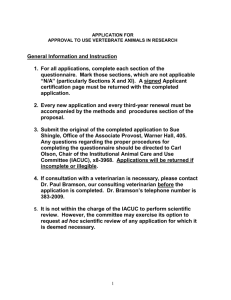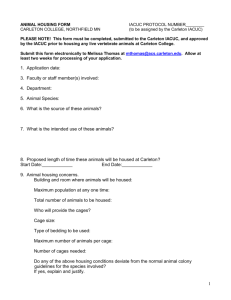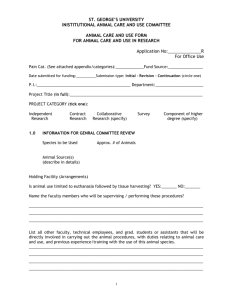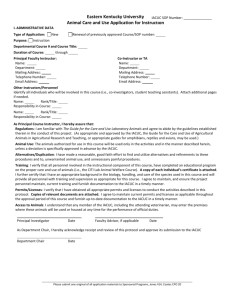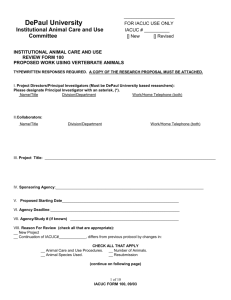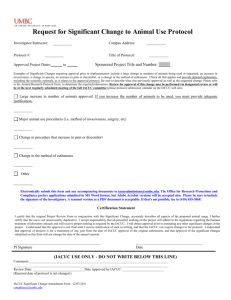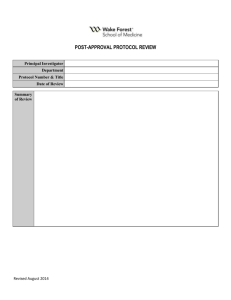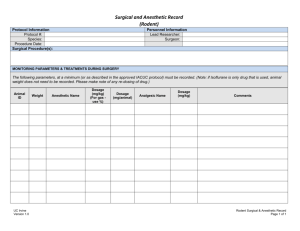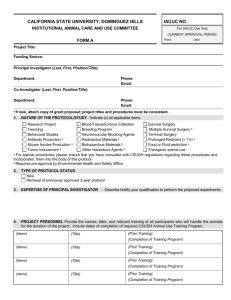ANIMAL USE FORM (revised 8/94) IACUC
advertisement
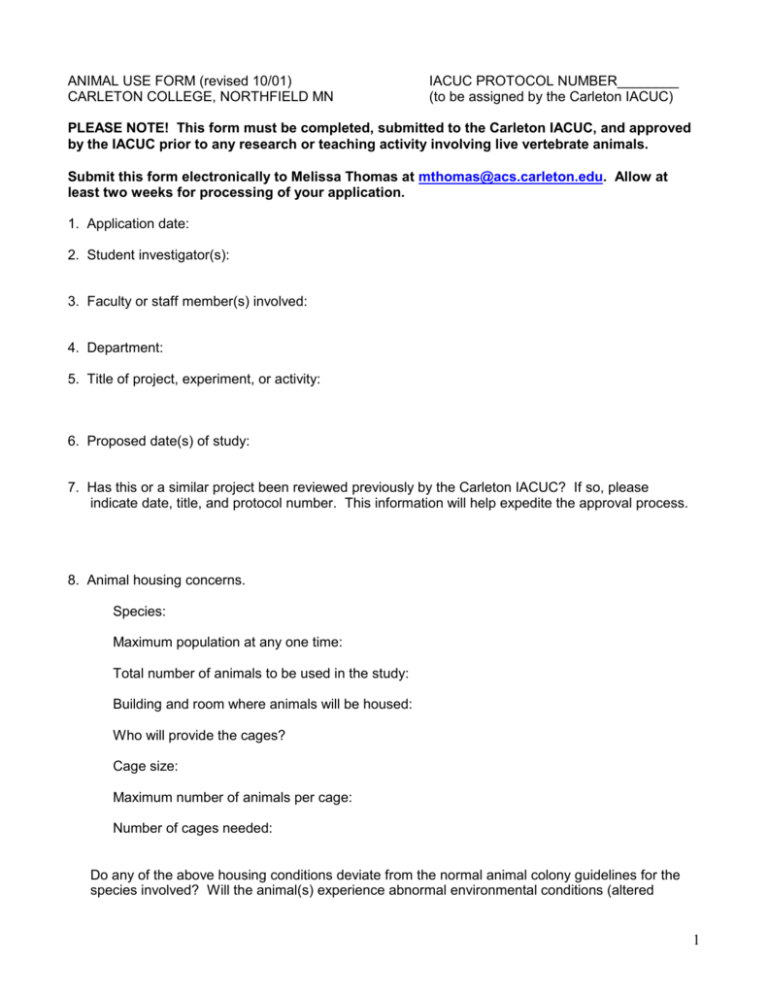
ANIMAL USE FORM (revised 10/01) CARLETON COLLEGE, NORTHFIELD MN IACUC PROTOCOL NUMBER________ (to be assigned by the Carleton IACUC) PLEASE NOTE! This form must be completed, submitted to the Carleton IACUC, and approved by the IACUC prior to any research or teaching activity involving live vertebrate animals. Submit this form electronically to Melissa Thomas at mthomas@acs.carleton.edu. Allow at least two weeks for processing of your application. 1. Application date: 2. Student investigator(s): 3. Faculty or staff member(s) involved: 4. Department: 5. Title of project, experiment, or activity: 6. Proposed date(s) of study: 7. Has this or a similar project been reviewed previously by the Carleton IACUC? If so, please indicate date, title, and protocol number. This information will help expedite the approval process. 8. Animal housing concerns. Species: Maximum population at any one time: Total number of animals to be used in the study: Building and room where animals will be housed: Who will provide the cages? Cage size: Maximum number of animals per cage: Number of cages needed: Do any of the above housing conditions deviate from the normal animal colony guidelines for the species involved? Will the animal(s) experience abnormal environmental conditions (altered 1 temperature, humidity, lighting, etc.)? If so, please explain what the changes are, and why they will occur. 2 9. Dietary concerns. Species: Food(s) provided: Liquid(s) provided: Will access to food or liquid be limited? If so, please explain and justify. Will the diet indicated above deprive the animal(s) of any specific nutrient(s)? If so, please explain and justify. 10. Please attach to this form a copy of your proposed method (include subjects, apparatus and ALL experimental procedures, even if they have been approved for a previous protocol.) This will allow committee members to review the entire experience proposed for the animals in this particular study. The committee reviews animal use requests as complete studies; previous approval of a particular procedure under one set of circumstances does not necessarily guarantee approval under a different set of circumstances. 11. Will the animals in the proposed study be exposed to any specific hazard(s)? Please consider pathogens, such as viruses, bacteria, or malignant cells, as well as chemicals, carcinogens, recombinant DNA, and radioactive materials. Specify the hazard(s), and describe the precautions that will be taken to safeguard the welfare of the animal(s) and minimize their distress. 12. Describe the precautions that will be taken to minimize risk to researchers and animal care personnel. How will biohazardous materials (including animal wastes and carcasses) generated by this study be decontaminated and/or disposed of? 13. Will any drugs be administered to the animal(s) during the course of the proposed study? If so, please describe below. a. Drugs for experimental purposes. Species: Drug: Dose: Route of administration: Expected effect on animal: Expected duration of effect: 3 b. How did you decide on drug/dosage for this use? (For example, a published reference, advice of a colleague with experience in this area. Please be specific.) 4 c. Drugs administered for alleviation of pain/distress (include analgesics, anesthetics, and tranquilizers). Species: Drug: Dose: Route of administration: Expected effect on animal: Expected duration of effect: d. How did you decide on drug/dosage for this use? (For example, a published reference, advice of a colleague with experience in this area. Please be specific.) e. Drugs administered for euthanasia purposes. Species: Drug: Dose: Route of administration: f. How did you decide on drug/dosage for this use? (For example, a published reference, advice of a colleague with experience in this area. Please be specific.) 14. Will surgery be performed on the animal(s) in this study? If so, please indicate what the surgery will consist of, who will perform it, where it will be performed, where the animal(s) will recover, and what, if any, special post-operative care will be necessary. PLEASE NOTE! You will need to keep a surgical log of these activities, to be provided to the committee upon request. This log should contain, for each animal, a record of kinds and amounts of drugs administered, surgical procedures performed, complications encountered, and eventual cause of death. Date and name(s) of researchers (s) should accompany each entry. 15. What will happen to the animal(s) at the conclusion of this study? Please indicate whether care will be maintained, or whether the animal(s) will be euthanized. Animals from this study should not be used in any other study or for any other purpose without an additional Animal Use Form being approved by the IACUC. For a discussion of acceptable methods of euthanasia, see the 1978 American Veterinary Medical Association publication Report of the AVMA Panel on Euthanasia (J. Am. Vet. Med. Assn. 188(3), 252-268.) 5 16. Please categorize the overall pain, distress and/or trauma that the animal(s) involved in this study will encounter. (Categories were adapted from the Swedish Classification of Research Experiments, and the Scientist's Center for Animal Welfare bulletin "Categories of Biomedical Experiments Based on Increasing Ethical Concerns for Non-human Species".) _____(a) Experiment is completely non-invasive and non-traumatic. Animals will be observed, without manipulation of their environment. _____(b) Experiment is expected to produce little or no discomfort. This category includes: occasional simple invasive procedures such as blood sampling or injections; physical behavioral testing without significant restraint or noxious stimuli; experiments on completely anesthetized animals which do not regain consciousness; and standard methods of euthanasia that induce rapid, painless unconsciousness, such as anesthetic overdose. _____(c) Experiment is expected to produce some discomfort. This category includes procedures that cause minor discomfort, anxiety, or pain of short duration, such as: behavioral experiments on awake animals that involve restraint; food/water deprivation for short periods (<24 hrs for warm blooded animals); noxious stimuli from which escape is possible; social isolation or crowding; repetitious minor invasive procedures, such as frequent repeated blood sampling; surgical procedures under anesthesia from which the animal will recover consciousness; exposure of blood vessels and implantation of chronic catheters; and gonadectomy by standard methods. Category (c) procedures incur additional concern in proportion to the degree and duration of distress or discomfort. _____(d) Experiment is expected to involve significant but unavoidable distress or pain. This category includes: induction of behavioral stress in order to test its effect; major surgical procedures under anesthesia that will result in significant post-operative discomfort or functional deficit; application of noxious stimuli from which escape is not possible; and prolonged periods (several hours or more) of physical restraint. Category (d) experiments present an explicit responsibility on the investigator(s) to explore alternative experimental designs to ensure that unavoidable distress is minimized. _____(e) Experiment is expected to inflict severe pain on unanesthetized, conscious animals. Experiments in this category are generally considered inappropriate for research at Carleton; IACUC approval for category (e) experiments is highly unlikely. Such experiments include: use of muscle relaxants or paralytic drugs for surgical restraint without the concomitant use of anesthetics in sufficient dosage to produce loss of consciousness; administration of colchicine to block central transmission of neurotransmitters; severe trauma inflicted on unanesthetized, conscious animals; recovery of consciousness after severe physical trauma has been inflicted under anesthesia; and any other traumatic procedures or experiments performed without the use of anesthetics, analgesics, and/or tranquilizers, including toxicity testing, exposure to radiation, burns, and drug addiction. ******************************************************************************************************************** ****** I certify that the information provided on this form is complete and correct to the best of my knowledge. All faculty, staff, and student investigators named on the first page must sign below. Name (please print) Signature Date 6 7

